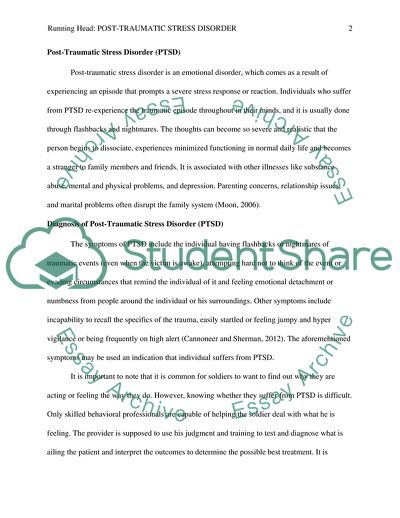Cite this document
(Diagnosis, Treatment, and Re-Integration for Soldiers with Symptoms of Thesis, n.d.)
Diagnosis, Treatment, and Re-Integration for Soldiers with Symptoms of Thesis. https://studentshare.org/psychology/1793587-diagnosis-and-treatment-and-re-integration-for-soldiers-who-return-from-combat-with-symptoms-of-post-traumatic-stress-syndrome-who-return-from-combat-with-symptoms-of-ptsd
Diagnosis, Treatment, and Re-Integration for Soldiers with Symptoms of Thesis. https://studentshare.org/psychology/1793587-diagnosis-and-treatment-and-re-integration-for-soldiers-who-return-from-combat-with-symptoms-of-post-traumatic-stress-syndrome-who-return-from-combat-with-symptoms-of-ptsd
(Diagnosis, Treatment, and Re-Integration for Soldiers With Symptoms of Thesis)
Diagnosis, Treatment, and Re-Integration for Soldiers With Symptoms of Thesis. https://studentshare.org/psychology/1793587-diagnosis-and-treatment-and-re-integration-for-soldiers-who-return-from-combat-with-symptoms-of-post-traumatic-stress-syndrome-who-return-from-combat-with-symptoms-of-ptsd.
Diagnosis, Treatment, and Re-Integration for Soldiers With Symptoms of Thesis. https://studentshare.org/psychology/1793587-diagnosis-and-treatment-and-re-integration-for-soldiers-who-return-from-combat-with-symptoms-of-post-traumatic-stress-syndrome-who-return-from-combat-with-symptoms-of-ptsd.
“Diagnosis, Treatment, and Re-Integration for Soldiers With Symptoms of Thesis”. https://studentshare.org/psychology/1793587-diagnosis-and-treatment-and-re-integration-for-soldiers-who-return-from-combat-with-symptoms-of-post-traumatic-stress-syndrome-who-return-from-combat-with-symptoms-of-ptsd.


